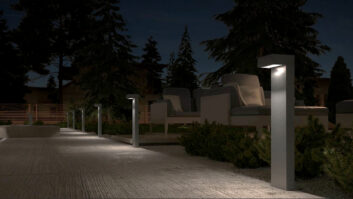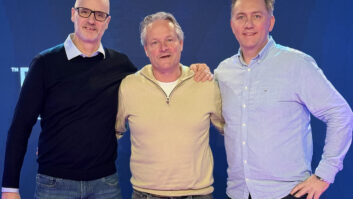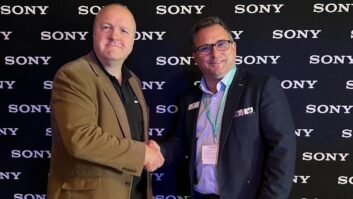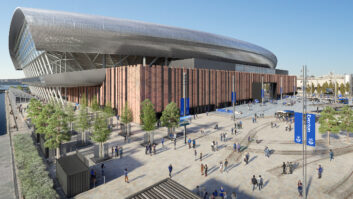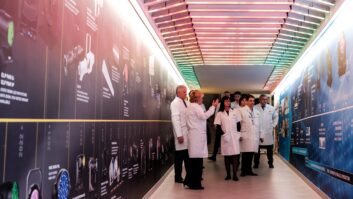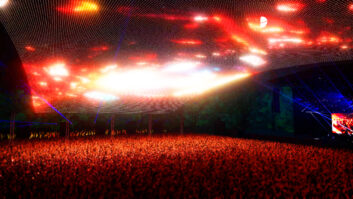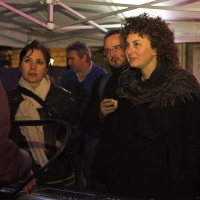
A.C. Special Projects (ACSP) has hosted what the company describes as a very successful “Control of Colour Changing LEDs” Lighting Workshop at Somerset House in London in conjunction with the Professional Lighting Designers’ Association (PLDA).
Somerset House was chosen because of the scope it provided for a ‘hands on’ demonstration. It is a spectacular neo-classical building in the heart of London, sitting between the Strand and the River Thames. During summer months, 55 fountains dance in the courtyard, and in winter it is possible to skate on London’s favourite ice rink. Somerset House also hosts open-air concerts and films, and contemporary art and design exhibitions. Normally running in a stylish classic warm white on three of the impressive neoclassical building facades, the idea behind the workshop was to illustrate the different control options for the scheme, and show how the application of colour can transform the look and feel of an environment.
The Somerset House lighting scheme comprises over 150 Anolis LED fixtures and RGBA lightsources which, with their potential for colour mixing, brings a theatrical dimension if required for the various public, corporate and themed events for which the space is utilised all year round. The completed scheme was programmed on a full size lighting console and then transferred to a compact PC system for playback and day-to-day running. For this task, a Jands Vista T4 console and Vista PC controller were chosen.
Using the Jands Vista control platform, attendees were able to take control of the venue’s architectural lighting scheme – which was supplied, installed and programmed by A.C. Special Projects in 2009.
A.C.’s technical product manager, Neil Vann, set up three Vista consoles for the PLDA Workshop, each of which was controlling lighting fixtures on a different facade of the Fountain Court.
The workshop started with a brief overview and ‘walk-through’ of the console’s core features and functions by Neil, after which the designers were split into three groups. Each was given a series of tasks involving changing the colours and creating different looks for the building. “We wanted to make it fun, informative, interactive and a proper practical exercise,” said Vann.
He added that it was the first time the majority of attendees had ever directly used this type of console. “Even I was impressed that all of the exercises proved how straightforward and intuitive the Jands Vista platform is to set up and programme on a first time basis,” Vann continued. “By the end of the evening, the majority of designers were really comfortable with the basics of the consoles and how to create, programme and edit cues.”
Architectural lighting designers will produce an aesthetic concept and often specify the fixtures to be used for a scheme; however, the control and programming elements of a project are frequently undertaken by other practitioners. This workshop was an opportunity for them to experience the flexibility and power of using a live console for ‘direct access’ to fixtures, and see first-hand how control and using specific lightsources can add long term flexibility to any lighting scheme.
Places on the workshop were initially limited to 18 to ensure that everyone received the best attention when learning the Vista consoles. However, such was the buzz about the event that some extras were also welcomed and accommodated.
Participant comments included:
Ela Keen from The Light Bureau: “It was great to be able to learn how the large consoles work and see the effects immediately right there on the building.”
Rachel Nichols, studying an MSc in Light & Lighting at UCL: “It was an excellent opportunity to get hands-on with the control of such a large scale scheme.”
Alistair Scott, from Designs For Lighting and president of the Institute of Lighting Professionals: “It was a really valuable experience all round. Every lighting designer should have a rig like this to experiment with!”
Victor Garcia of SMA: “The workshop was very interesting. Being hands-on with the kit and seeing the effect of controlling and changing the lights immediately was brilliant.”
Vicky Malakasi of Arup Lighting: “It was great to play with the lights. It’s amazing how many ideas you can get when actually seeing some colours together in situ for the first time, combinations that you might never have imagined! It’s also good to see close up the effects of different colours in a real context like illuminating a building.”
Paul Traynor of The Light Bureau (and past president of the PLDA): “Control is sometimes considered a ‘dark art,’ and we will collaborate with control specialists in our work, but being able to actually do it for ourselves in this sort of an environment, then you realise what a powerful – and ultimately accessible – creative tool it really is.”
